Antoni Tàpies
(Barcelona 1923 - 2012 Barcelona)
"Dues fletxes blanques"
(Zwei weiße Pfeile)
Malerei und Bleistift auf Papier 1988
112 x 77 cm
sign.
Agustí 5644
[24486]
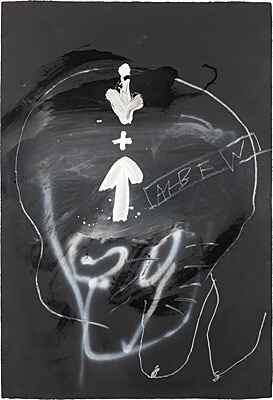
Antoni Tàpies
(Barcelona 1923 - 2012 Barcelona)
"Dues fletxes blanques"
(Zwei weiße Pfeile)
Malerei und Bleistift auf Papier 1988
112 x 77 cm
sign.
Agustí 5644
[24486]
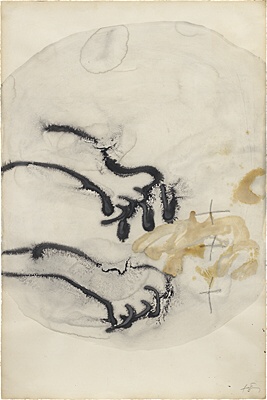
Antoni Tàpies
(Barcelona 1923 - 2012 Barcelona)
"Dues urpes"
(Zwei Krallen)
Mischtechnik auf Papier 1989
120 x 80 cm
sign.
Agustí 5809
[24487]
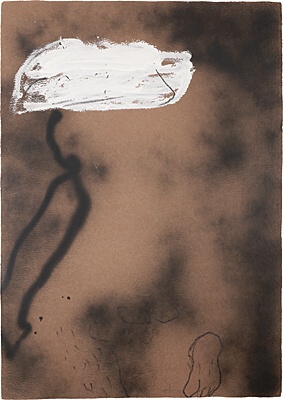
Antoni Tàpies
(Barcelona 1923 - 2012 Barcelona)
"Tors sobre fons negre"
(Torso auf schwarzem Hintergrund)
Malerei und Bleistift auf Papier 1989
117,5 x 83,5 cm
sign.
Agustí 5815
[24488]
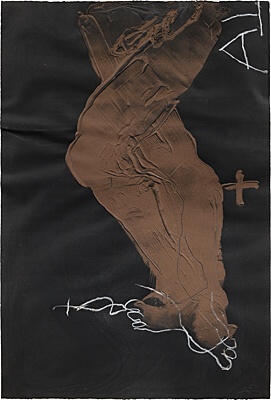
Antoni Tàpies
(Barcelona 1923 - 2012 Barcelona)
"Cames"
(Beine)
Malerei und Bleistift auf Papier 1989
111,5 x 76,5 cm
sign.
Agustí 5816
[24489]
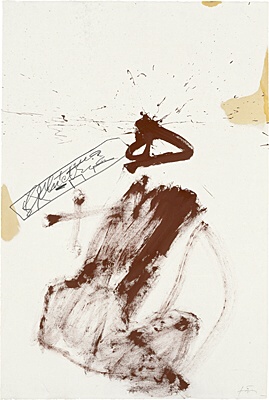
Antoni Tàpies
(Barcelona 1923 - 2012 Barcelona)
"Formes roges"
(Rote Formen)
Malerei und Bleistift auf Papier 1991
120 x 80,5 cm
sign.
Agustí 6366
[24485]
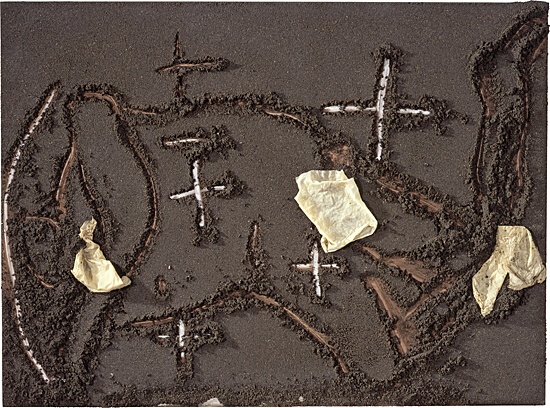
Antoni Tàpies
(Barcelona 1923 - 2012 Barcelona)
"Tres draps"
(Drei Tücher)
Mischtechnik auf Holz 2001
96,6 x 129,5 cm
sign.
Agustí 7436
[24483]
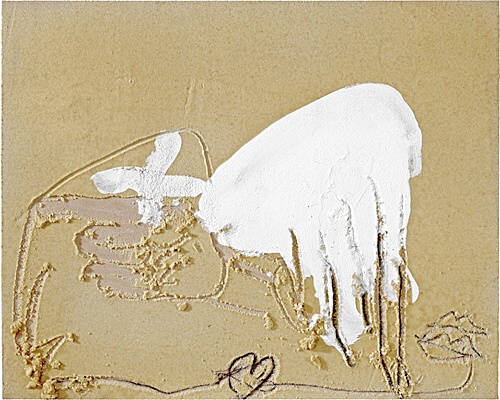
Antoni Tàpies
(Barcelona 1923 - 2012 Barcelona)
"Ala blanca"
(Weißer Flügel)
Mischtechnik auf Holz 2006
65 x 81 cm
sign.
noch nicht bei Agustí
[24490]
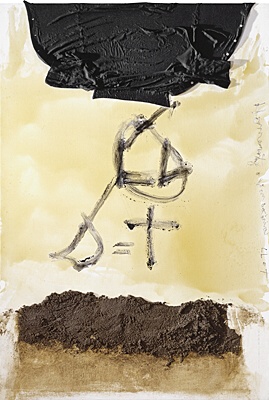
Antoni Tàpies
(Barcelona 1923 - 2012 Barcelona)
"Homenatge a la matèria"
(Hommage an die Materie)
Mischtechnik und Collage auf Leinwand 2006
195 x 130 cm
sign. bez.
noch nicht bei Agustí
[24491]
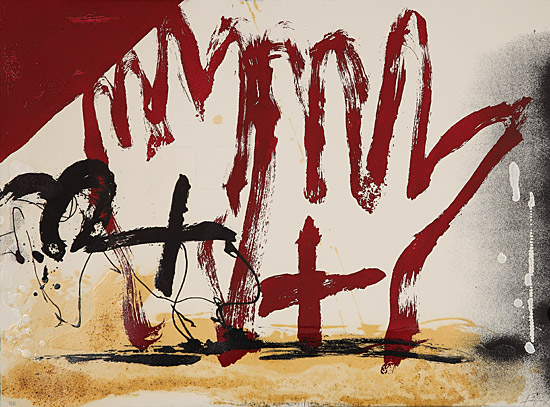
Antoni Tàpies
(Barcelona 1923 - 2012 Barcelona)
"Les vostres mans"
(Eure Hände)
Farbaquatinta und Farbserigraphie mit Sand und Prägedruck 1989
56 x 76 cm
sign. num.
Auflage ca. 51 Exemplare
Galfetti/Homs 1242
[26308]
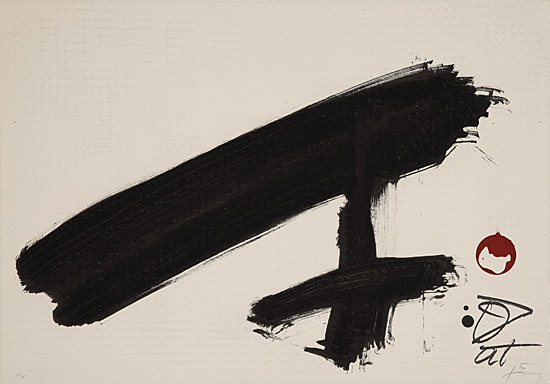
Antoni Tàpies
(Barcelona 1923 - 2012 Barcelona)
"Forma diagonal"
(Diagonale Form)
diverse Aquatintatechniken 1992
62 x 87 cm
sign. num.
Auflage 80 Exemplare
Galfetti/Homs 1357
[26484]
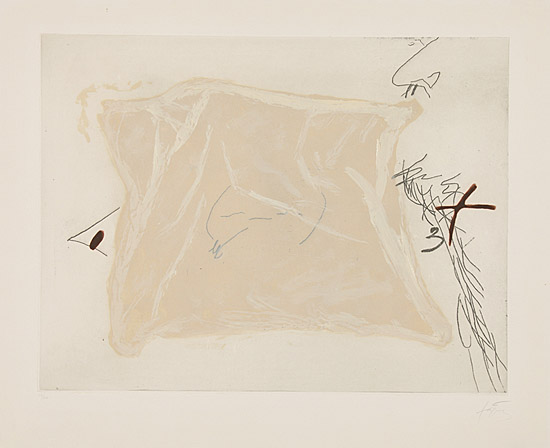
Antoni Tàpies
(Barcelona 1923 - 2012 Barcelona)
"Mouchoir"
(Taschentuch)
Farbradierung, Vernis mou mit Carborundum 1971
62,9 x 76,7 cm, Pr. 49,7 x 64,3 cm
sign. num.
Auflage 100 Exemplare
Galfetti 0251
[20088]
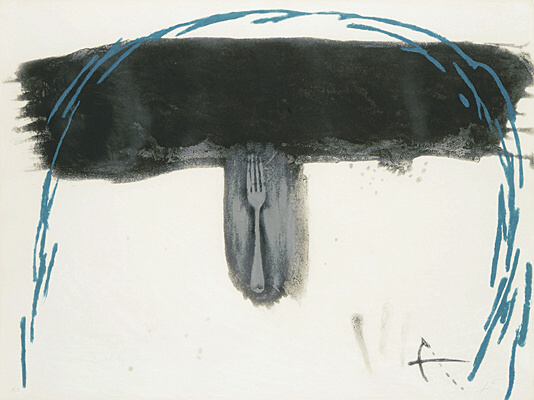
Antoni Tàpies
(Barcelona 1923 - 2012 Barcelona)
"Arc blau"
(Blauer Bogen)
Farbradierung mit Carborundum 1972
58,2 x 77,5 cm
sign. bez.
Auflage 75 Exemplare
Galfetti 0288
[19587]
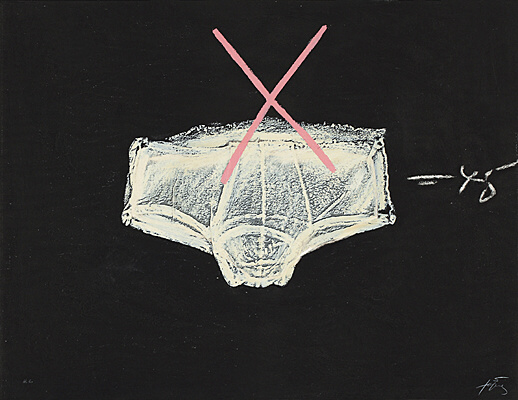
Antoni Tàpies
(Barcelona 1923 - 2012 Barcelona)
"Roba interior"
(Unterwäsche)
Farbradierung mit Carborundum und Handkolorierung 1972
58,8 x 77 cm
sign. bez.
Auflage ca. 75 Exemplare
Galfetti 0294
[18971]
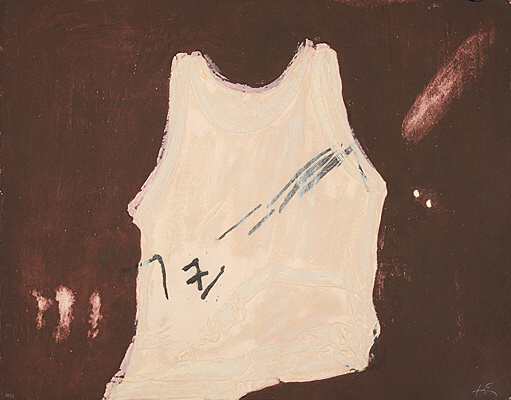
Antoni Tàpies
(Barcelona 1923 - 2012 Barcelona)
"Samarreta"
(Unterhemd)
Farbradierung mit Carborundum, das Weiß von Hand gehöht 1972
59,8 x 76,3 cm
sign. num.
Auflage ca. 80 Exemplare
Galfetti 0300
[22340]
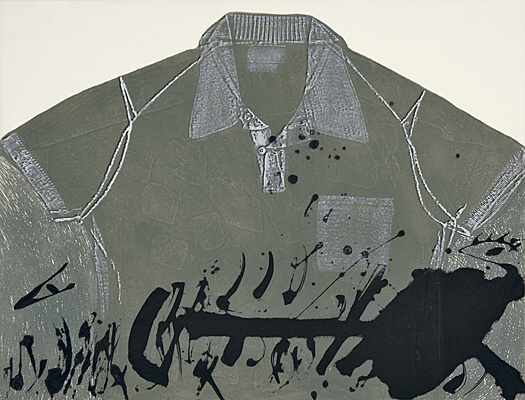
Antoni Tàpies
(Barcelona 1923 - 2012 Barcelona)
"Camisa"
(Hemd)
Farbradierung mit Carborundum und handaufgetragenem Weiß 1972
59 x 77 cm
sign. bez.
Auflage ca. 75 Exemplare
Galfetti 0301
[16859]
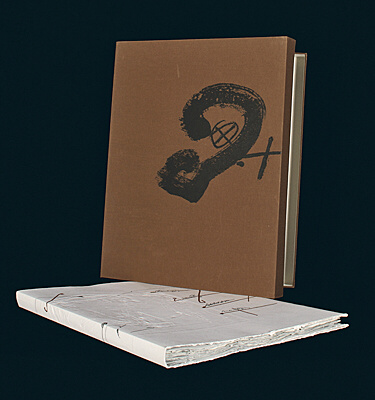
Antoni Tàpies
(Barcelona 1923 - 2012 Barcelona)
"Petrificada petrificante" (Octavio Paz)
Buch mit 8 graphischen Arbeiten und kompletter Suite (ungefaltet) 1978
55 x 44 cm x 5 cm
sign. num.
Auflage ca. 195 Exemplare
Galfetti 0698-705
[22561]
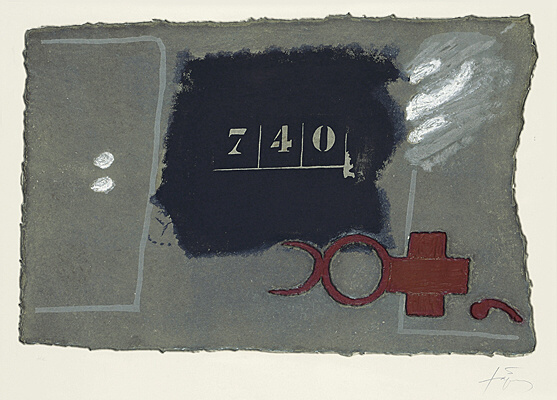
Antoni Tàpies
(Barcelona 1923 - 2012 Barcelona)
"740"
Radierung, Aquatinta und Carborundum 1979
56 x 72,5 cm, Pr. 38,5 x 58,5 cm
sign. bez.
Auflage 95 Exemplare
Galfetti/Homs 0715
[19588]
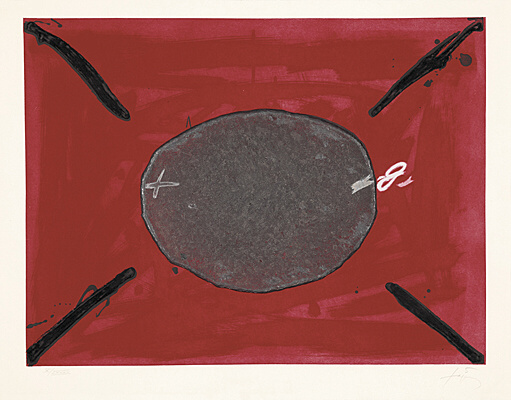
Antoni Tàpies
(Barcelona 1923 - 2012 Barcelona)
"Oval"
Farbaquatintaradierung mit Carborundum 1979
56,5 x 72 cm, Abb. 48,7 x 64,5 cm
sign. num.
Auflage ca. 100 Exemplare
Galfetti/Homs 0728
[21248]
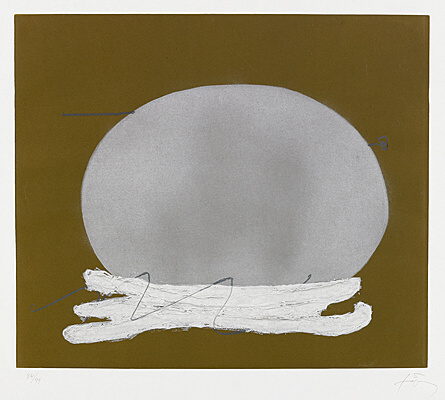
Antoni Tàpies
(Barcelona 1923 - 2012 Barcelona)
"Oval i blanc"
(Oval und Weiß)
Farbaquatintaradierung mit Carborundum 1982
56 x 76,7 cm, Pr. 41,5 x 48,5 cm
sign. num.
Auflage ca. 135 Exemplare
Galfetti/Homs 0849
[19610]
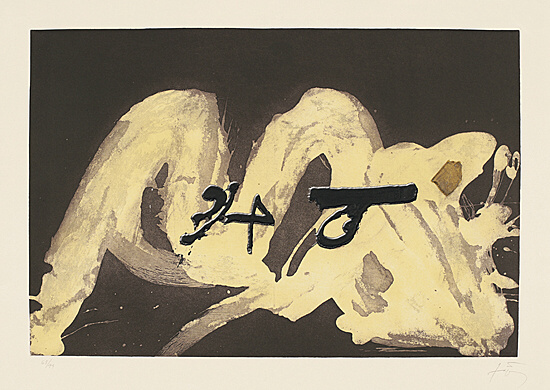
Antoni Tàpies
(Barcelona 1923 - 2012 Barcelona)
"3 i 4"
(3 und 4)
Farbaquatintaradierung mit Carborundum 1982
56,5 x 76,5 cm, Pr. 44 x 65,5 cm
sign. num.
Auflage ca. 135 Exemplare
Galfetti/Homs 0851
[15784]
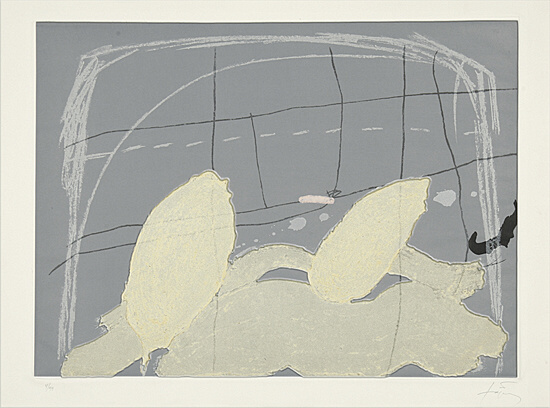
Antoni Tàpies
(Barcelona 1923 - 2012 Barcelona)
"Aparicions 5" aus "Aparicions"
(Erscheinungen)
Farbradierung mit Carborundum mit Pulver bestäubt 1982
56,5 x 76 cm, Pr. 49 x 66,5 cm
sign. num.
Auflage ca. 140 Exemplare
Galfetti/Homs 0891
[18872]
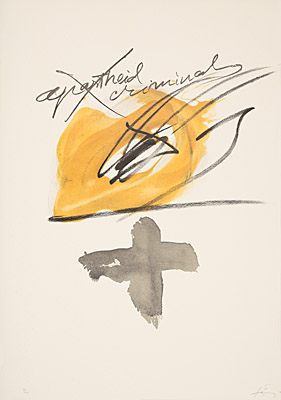
Antoni Tàpies
(Barcelona 1923 - 2012 Barcelona)
"Against Apartheid"
(Gegen Apartheid)
Farblithographie aus dem gleichnamigen Mappenwerk 1983
85,1 x 60 cm
sign. num.
Auflage 130 Exemplare
Galfetti/Homs 916
[26152]
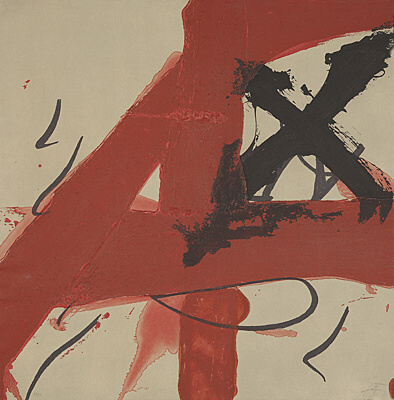
Antoni Tàpies
(Barcelona 1923 - 2012 Barcelona)
"A 4"
Farbaquatintaradierung mit Carborundum 1985
75 x 74,5 cm
sign. num.
Auflage ca. 135 Exemplare
Galfetti/Homs 1016
[22827]
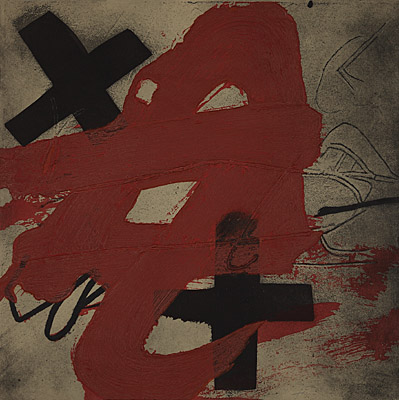
Antoni Tàpies
(Barcelona 1923 - 2012 Barcelona)
"A.T."
Farbaquatintaradierung mit Carborundum 1985
75 x 75 cm
sign. num.
Auflage ca. 135 Exemplare
Galfetti/Homs 1017
[26335]
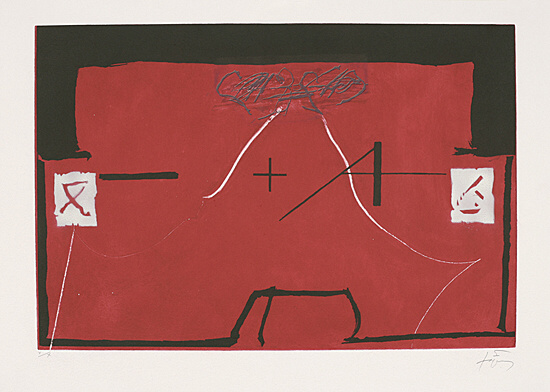
Antoni Tàpies
(Barcelona 1923 - 2012 Barcelona)
ohne Titel aus "El rei de la màgia"
(aus "Der König der Magie")
Farbradierung 1986
65 x 85 cm, Pr. 46,7 x 69 cm
sign. num.
Auflage 145 Exemplare
Galfetti/Homs 1082
[16090]
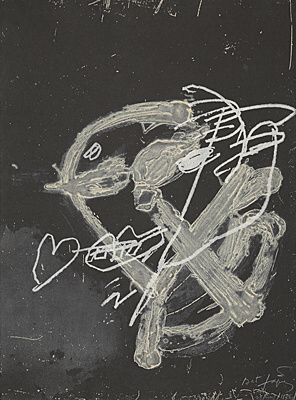
Antoni Tàpies
(Barcelona 1923 - 2012 Barcelona)
"Blanc sur noir"
(Weiß auf Schwarz)
Aussprengaquatinta mit Carborundum 1986/1987
76 x 56,8 cm
sign. dat. bez.
Auflage 70 Exemplare
Galfetti/Homs 1102
[23379]
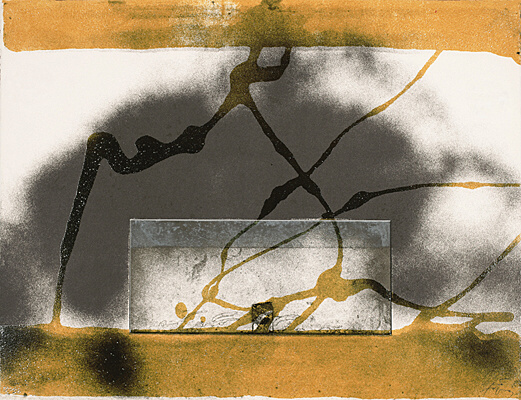
Antoni Tàpies
(Barcelona 1923 - 2012 Barcelona)
"Regalim"
Siebdruck, Lithographie auf Radierung 1987
50,2 x 66 cm
sign. num.
Auflage 68 Exemplare
Galfetti/Homs 1106
[15715]
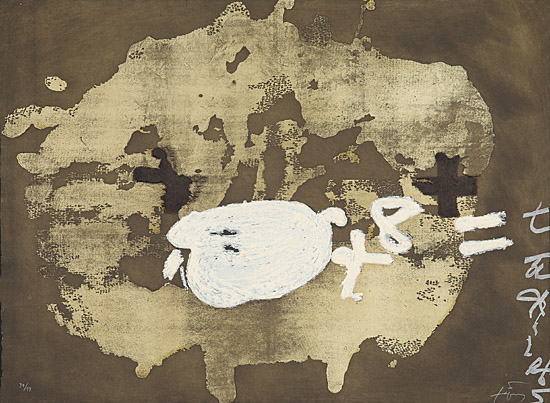
Antoni Tàpies
(Barcelona 1923 - 2012 Barcelona)
"Objectes"
(Objekte)
Farbaquatintaradierung mit Carborundum 1987
56,2 x 76,2 cm
sign. num.
Auflage 135 Exemplare
Galfetti/Homs 1126
[25583]
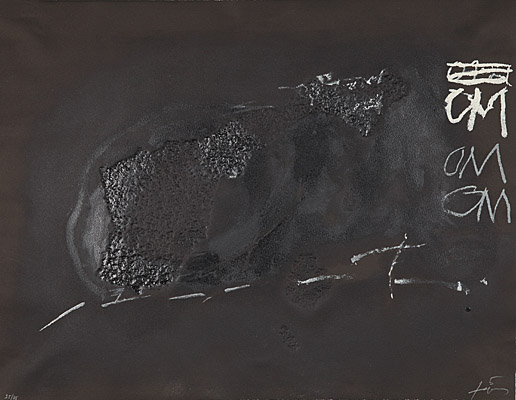
Antoni Tàpies
(Barcelona 1923 - 2012 Barcelona)
"Variations sur un thème musical 20"
(Variationen über ein musikalisches Thema 20)
Farblithographie mit Prägedruck 1987
53,7 x 69 cm
sign. num.
Auflage ca. 110 Exemplare
Galfetti/Homs 1161
[25656]
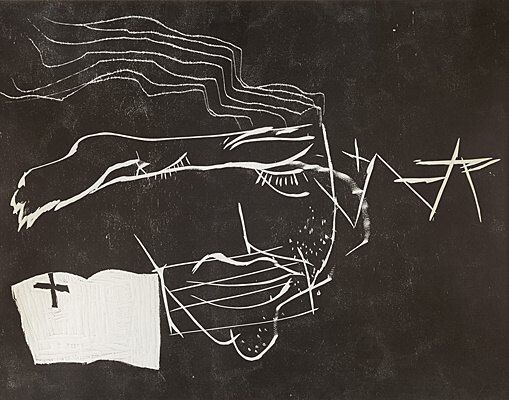
Antoni Tàpies
(Barcelona 1923 - 2012 Barcelona)
"Le lecteur"
(Der Leser)
Holzschnitt 1990
99,3 x 129 cm
sign. bez.
Auflage ca. 55 Exemplare
Galfetti/Homs 1278
[23821]
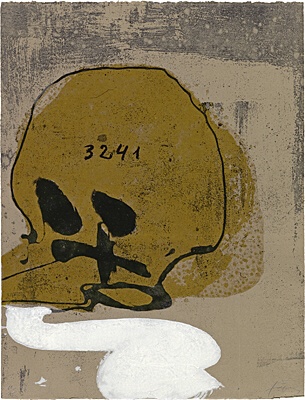
Antoni Tàpies
(Barcelona 1923 - 2012 Barcelona)
"Crani amb xifres"
(Schädel mit Ziffern)
Radierung, Aquatinta, Carborundum und Siebdruck, teilweise lackiert 1992
65,5 x 50 cm
sign. num.
Auflage ca. 55 Exemplare
Galfetti/Homs 1351
[24498]
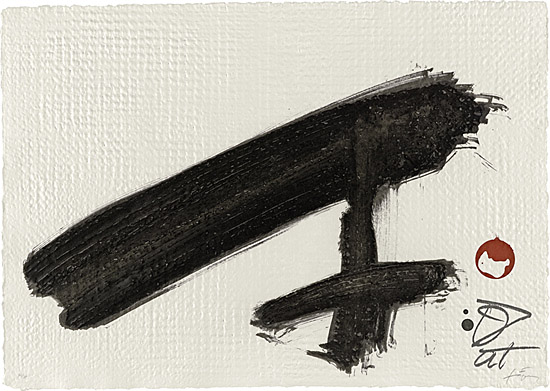
Antoni Tàpies
(Barcelona 1923 - 2012 Barcelona)
"Forma Diagonal"
Farbradierung mit Carborundum 1992
61,5 x 86,5 cm
sign. num.
Auflage 80 Exemplare
Galfetti/Homs 1357
[21890]
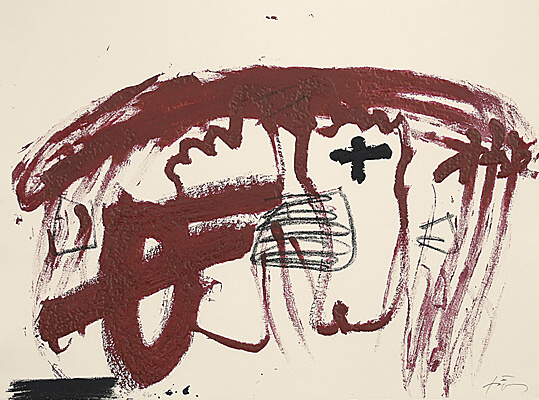
Antoni Tàpies
(Barcelona 1923 - 2012 Barcelona)
"Carmí 6"
(Karminrot 6)
diverse Aquatintatechniken mit Carborundum 1994
56,5 x 76 cm
sign. num.
Auflage 80 Exemplare
Galfetti/Homs 1447
[19643]
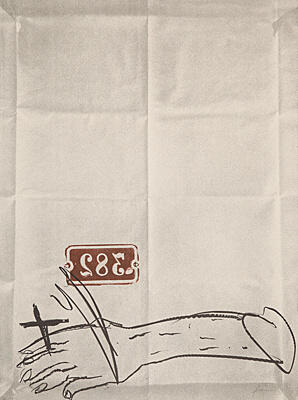
Antoni Tàpies
(Barcelona 1923 - 2012 Barcelona)
"Bras et chiffres"
(Arm und Ziffern)
Farblithographie auf Offset-Hintergrund 1997/2011
80 x 60 cm
sign. num.
Auflage ca. 140 Exemplare
Galfetti/Homs 1536
[23338]
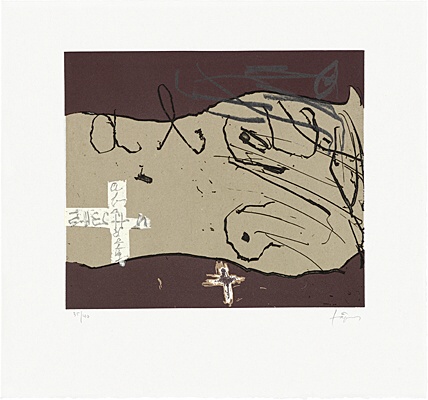
Antoni Tàpies
(Barcelona 1923 - 2012 Barcelona)
"Cos i creus"
(Körper und Kreuze)
Walztechnik, Radierung, Weichgrundradierung, Siebdruck, Lithographie 2005
46 x 49,5 cm
sign. num.
Auflage ca. 55 Exemplare
Galfetti/Homs 1637
[24499]
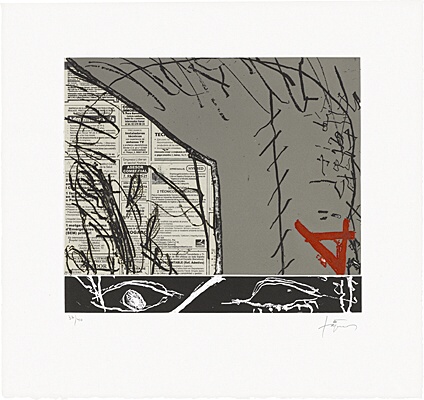
Antoni Tàpies
(Barcelona 1923 - 2012 Barcelona)
"Cosit"
(Naht)
Radierung, Aquatinta und Walztechnik mit Zeitungspapiercollage 2005
46,5 x 49,5 cm, Pr. 25,5 | 4,5 x 35 | 35 cm
sign. num.
Auflage ca. 50 Exemplare
Galfetti/Homs 1638
[24502]
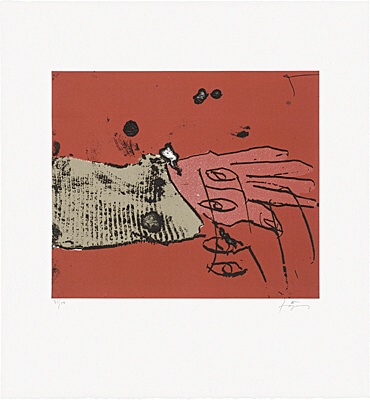
Antoni Tàpies
(Barcelona 1923 - 2012 Barcelona)
"Quatre ulls"
(Vier Augen)
Walztechnik, Radierung mit Papiercollage 2006
51,5 x 48 cm, Pr. 29,5 x 35 cm
sign. num.
Auflage ca. 50 Exemplare
Galfetti/Homs 1645
[24503]
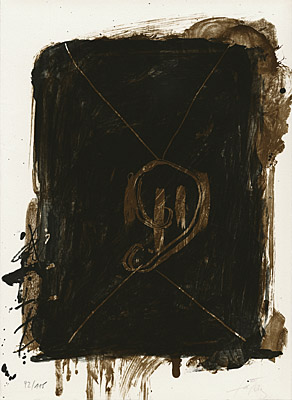
Antoni Tàpies
(Barcelona 1923 - 2012 Barcelona)
ohne Titel
aus "Vingt-deux poèmes" (Cassou)
Farblithographie Zeitraum 1964/1978
38,2 x 28,2 cm, Abb. 38,2 x 28,2 cm
sign. num.
Auflage 90 Exemplare
[25797]
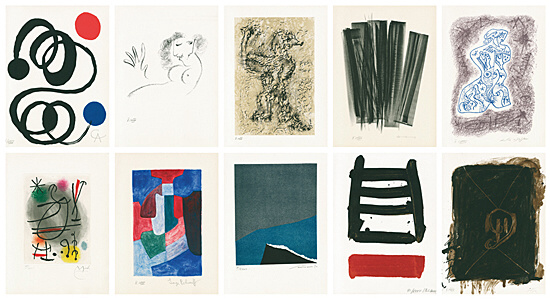
Jean Cassou
(1897 Deusto/Bilbao - 1986 Paris)
"Vingt-deux poèmes"
(Zweiundzwanzig Gedichte mit Originalgraphiken)
vollständig illustriertes Buch 1978
39,5 x 29,5 cm x 4,5 cm
sign. num. dat.
Auflage 150 Exemplare
Cramer 107 Chagall Cramer 240 Miró
[23467]
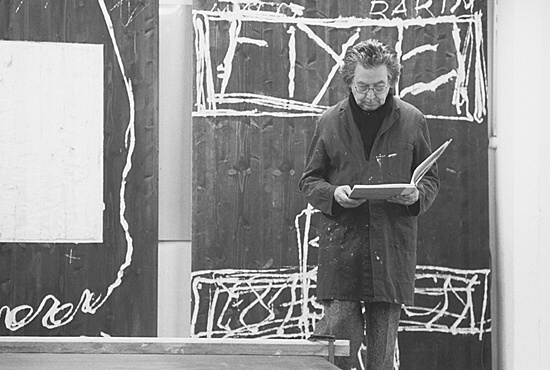
Antoni Tàpies im graphischen Atelier, St. Gallen 9. Dezember 1992
© 2019 Franziska Messner – Rast, St. Gallen
As probably the most important Spanish Informel artist, Antoni Tàpies (Barcelona 1923–2012 Barcelona) is represented in all international museums with his expressive material pictures. His paintings were created by applying thick layers of paint, which he repeatedly scraped off and re-applied until the surfaces were reminiscent of rough, cracked walls. He added sand, cement, marble dust, glue and collages of various materials and found objects, as well as overpaintings reminiscent of graffiti.
As a brilliant printmaker, Tàpies also mastered all original printmaking techniques and succeeded – like very few of his contemporaries – in captivating the power of his painting in prints as well. In the field of twentieth-century abstract art, there is hardly an artist who has been able to integrate such a large number of expressive coloured etchings into his artistic work. Many of his coloured etchings, some of which are embellished with collages and overpaintings, have a three-dimensional quality that goes far beyond what one is generally accustomed to in printmaking.
Experimentation has always been his domain. In the late 1950s, his first material pictures emerged from the experimental handling of unusual materials, such as marble powder, sand, varnish, and collages. By experimenting with techniques, printing processes and materials, by combining, varying and transforming motifs, substances and surface textures, Antoni Tàpies also developed his prints and revealed within these an unprecedented wealth of ideas. He was fascinated by playing with the possibilities this medium offered him in the combination of various processes and in the range of expression: from the light and playful to the seemingly petrified, from vivid colour in lithography to the total deprivation of colour in embossing, from the poor disposable materials such as scraps of wrapping paper, adhesive tape and old newspaper pages to the imitation of a luxurious-looking dark-red velvet ribbon in the artist’s book. The spectrum of experimentation and variation seems inexhaustible.
Corresponding with his mixed technique in the material pictures, he also supplements the classical printing techniques – lithography, etching, synthetic resin aquatint, woodcut – with various materials and objects, which he also uses as a printing block: corrugated cardboard, textiles, lead letters, nails, safety pins, everyday objects used in his studio, such as spectacles, scissors, tools, spoons, knives, forks, brushes, rags, even clothes, underwear, socks, shoes or an old slate board. They have been an integral part of his repertoire of motifs for decades.
In addition, there are his recurring signs, which occasionally appear as reliefs, collages or traces of painting: the isosceles cross (...), the letters A and T – his initials, which simultaneously stand for Antoni and Teresa – the four red fingerprints associated with the Catalan flag, and finally his footprints and handprints, with which he documented his own aging process.
Over the years, Tàpies developed a fixed canon of motifs and materials that recurs in many variations, making his art legible as the legacy of the time in which he lived. Born in Barcelona in 1923, he experienced the Spanish Civil War as a teenager, followed by almost forty years of dictatorship. War, destruction, oppression and protest have shaped his art. As a contemporary witness, he has carved daily politics, historical events, legends and traditions into it – but also the quotidian, the many objects that came out of fashion and that we so directly associate with Spain: the shopping bags woven from cord, the flat natural fibre brooms with wooden sticks, old iron roller shutters and wooden folding shutters. Like the flotsam of the past, Tàpies has incorporated it into its art. Its traces can also be discovered in his prints.
Tàpies created most of his prints in the 1970s and early ’80s. These were explosive, political years in Spain. The first half was devoted to the final phase of the Franco regime, to Tàpies’s years of protest and struggle, which he accompanied with a series of manifesto-like works; the second to the achievement of democracy, after forty years of dictatorship a protracted process. In his art, such politically motivated works of those years stand out for their legible inscriptions and a, for Tàpies, unusually vibrant colouration of red and yellow, the colours of both Spain and Catalonia. In these years, a series of prints, various portfolios and thematic series appeared. A great deal of contemporary history can be read in them.
Highlights of Tàpies’s oeuvre of prints are his portfolios and artist’s books. Each of these objects has its own character. They lead the viewer directly into the elementary experience of an art that places the sense of touch alongside that of sight. Unlike the large material paintings, they no longer convey themselves solely through the eyes and that which memory accomplishes, by adding the sense of touch. The portfolio works and artist’s books are literally placed in our hands. They thus enable us to be very close to the work, making the creative act comprehensible in all phases. No framing, no glass separates the viewer from the composition.
The individual sheets lie in front of us. We turn them around, get to know them from two sides. With Antoni Tàpies, this is always associated with a surprise. Like a coin, each sheet has two sides. This is due to the special papers and the various embossing techniques that give the print its striking relief character. Over the years, some of the colours have also penetrated the reverse sides. One does not perceive it as a shortcoming, but as a further trace of a living artistic process.
Excerpts from: Barbara Catoir, ‘Wie eine Münze mit zwei Seiten, Beispiele des druckgrafischen Werks von Antoni Tàpies’, in: Antoni Tàpies. Malerei und Graphik, (Cologne: Galerie Boisserée 2011).
| 1923 | Tàpies wird am 13.12. in Barcelona geboren. |
| 1934 | Erste Zeichen- und Malversuche. Durch Zeitschriften hat er den ersten Kontakt zur zeitgenössischen Kunst und Literatur. |
| 1940 | Zweijähriger Sanatoriumsaufenthalt aufgrund eines akuten Herz- und Lungenleidens. Er widmet sich der Literatur, Philosophie und Musik. Er zeichnet viel und kopiert Bilder von van Gogh und Picasso. |
| 1943 | Beginn eines Jura-Studiums an der Universität in Barcelona, das er 1946 wieder aufgibt. |
| 1944 | Besucht für zwei Monate die Kunstakademie "Nolase-Valls". |
| 1945 | Werke mit pastosem Farbauftrag und Materialcollagen mit Schnüren, Erde, Zeitungs- und Toilettenpapier. |
| 1947 | Erste Ausstellung beim "Oktobersalon in Barcelona". |
| 1948 | Gründet mit anderen jungen Malern und Schriftstellern die Zeitschrift "Dau al Set". Im Oktober- Salon in Barcelona stellt er erstmals zwei Bilder aus. Eine Collage mit Kreuzen aus Toilettenpapier erregt heftige Diskussionen. |
| 1949 | Teilnahme an der Ausstellung "Un aspect de la peinture catalane" in Barcelona. Erste Radierungen. Seine Werke sind jetzt stark vom Surrealismus beeinflusst. |
| 1950 | Erste Einzelausstellung in Barcelona. Stipendium ermöglicht einen einjährigen Aufenthalt in Paris. |
| 1952 | Beteiligung an der XXVI. Biennale in Venedig. |
| 1953 | Erste Ausstellung bei Martha Jackson in New York. Beteiligung an der Biennale von Sao Paulo, wo er einen Preis gewinnt. |
| 1954 | Teilnahme an der Biennale in Venedig. Bekanntschaft mit Michel Tapié. |
| 1958 | Tàpies vertritt Spanien bei der Biennale in Venedig. |
| 1960 | Teilnahme an den Ausstellungen "New Spanish Painting and Sculpture" Museum of Modern Art , New York) und "Before Picasso-after Picasso" Guggenheim Museum, New York). |
| 1962 | Die Kestner-Gesellschaft, Hannover, zeigt die erste Retrospektive in Deutschland. Ausstellung im Guggenheim Museum, New York. |
| 1963 | Umzug in die Calle Zaragoza, Barcelona, wo er bis heute lebt und arbeitet. |
| 1964 | Auf der documenta III ist er mit einem eigenen Raum vertreten. |
| 1966 | Tàpies wird bei einer Versammlung von Antifrankisten verhaftet. |
| 1968 | Für die Fenster des Kapuzinerklosters in Sion entstehen mit Tusche bemalte Tücher als Vorhänge. |
| 1970 | Arbeit an einem großen Foyerbild für das Theater in St. Gallen. Im Dezember nimmt er mit Miró anlässlich eines Gerichtsverfahrens gegen baskische Nationalisten an einer Versammlung spanischer Intellektueller im Kloster Montserrat teil. |
| 1973 | Tàpies veröffentlicht in der Tageszeitung "La Vanguardia" eine Serie von Artikeln, die später in Buchform erscheinen. |
| 1974 | In Barcelona wird der junge spanische Oppositionelle Salvador Puig Antich hingerichtet. Tàpies schafft daraufhin eine Serie von Monotypien mit dem Titel "Mörder". |
| 1979 | Ernennung zum Mitglied der Berliner Akademie der Künste. |
| 1981 | In Saint-Paul-de-Vence entstehen unter der Anleitung des Töpfers Hans Spinner die ersten Skulpturen aus gebranntem Ton (Schamotte). |
| 1983 | Einweihung des Monuments für Picasso in Barcelona. |
| 1987 | Gründung der "Fundacio Antoni Tàpies" in Barcelona. |
| 1988 | Retrospektive im Musée Cantini, Marseille. |
| 1989 | Retrospektive des graphischen Werks in Peking. |
| 1990 | Eröffnung der "Fundacio Antoni Tàpies" in Barcelona. |
| 1992 | Es entstehen zwei große Wandarbeiten für den katalanischen Pavillon und den des Internationalen Olympischen Komitees auf der Weltausstellung in Sevilla. |
| 1993 | Im Spanischen Pavillon auf der Biennale von Venedig wird sein "Environment Rinzen" (Plötzliches Erwachen) gezeigt und mit dem Goldenen Löwen ausgezeichnet. |
| 1996 | Wanderretrospektive in Japan. |
| 1997 | Nimmt mit einem Vortrag zum Thema "L’art entre la despotisme et l’anarchie" an einem Forum der Académie Universelle des Cultures (Paris) zur Frage der Intoleranz teil. Retrospective im Museo Precci, Prato. |
| 2000 | Retrospektive im Museo Nacional Centro Sofia, Madrid, anschließend im Haus der Kunst, München. |
| 2001 | Ausstellung "Antoni Tàpies ou la Poétique de la matière" mit Graphiken und Illustrierten Büchern in der Bibliothèque Nationale de France, Paris. |
| 2002 | Retrospektive der Illustrierten Bücher in der Fundació Antoni Tàpies, Barcelona. |
| 2003 | Thematische Wanderausstellung "Antoni Tàpies. Cos i llenguatge" (Körper und Sprache), organisiert von der Fundació Antoni Tàpies. |
| 2004 | Retrospektive im Museu d’Art Contemporani de Barcelona (MACBA). |
| 2005 | Retrospektive im Hara Museum in Tokyo. Einzelausstellungen in London und Zürich. |
| 2006 | Einzelausstellungen in Paris, Madrid, Barcelona, Porto, Lissabon, London, New York und Toulon. |
| 2007 | Retrospektive im EMMA-Espo Museum of Modern Art, Finnland und Einzelausstellungen in Madrid, Valencia. |
| 2008 | Retrospektive in Toulouse, Prag, Berlin und Einzelausstellungen in Barcelona, London und Zürich. Zum 85. Geburtstag erscheinen das Mappenwerk "Tàpies escriu" (Tàpies schreibt) mit ausgewählten Texten von Antoni Tàpies und druckgraphischen Arbeiten verschiedener Künstler und zahlreiche Publikationen. |
| 2009 | Einzelausstellungen in New York und Catanzaro. |
| 2012 | Tàpies stirbt am 6. Februar in Barcelona. |
| 1958 | Erster Preis des Carnegie Instituts, Pittsburgh. |
| 1960 | Preis der Internationalen Biennale für Grafik in Tokio. |
| 1964 | Preis der Guggenheim Foundation, New York. |
| 1966 | Großer Preis der VI. Biennale di Mentone. |
| 1967 | Großer Preis der Grafik-Biennale Ljubljana. |
| 1972 | Rubens-Preis der Stadt Siegen. |
| 1974 | Erhält die Stephan-Lochner-Medaille der Stadt Köln. |
| 1979 | Literaturpreis der Stadt Barcelona für seine Autobiographie. |
| 1982 | Preis der Stiftung Wolf, Jerusalem (zusammen mit Chagall). |
| 1983 | Rembrandt-Preis der Stiftung M.Töpfer, Hamburg. |
| 1984 | Friedenspreis der spanischen Gesellschaft für die Vereinten Nationen. |
| 1985 | "Prix international de peinture" der französischen Regierung. Ernennung zum Mitglied der Königlichen Akademie der Schönen Künste in Schweden. |
| 1988 | Ehrendoktorwürde der Universität von Barcelona. "Commendeur de l’Ordre des Arts et des Lettres" der französischen Regierung. Ehrenmitglied der Gesellschaft Bildender Künstler österreichs. |
| 1990 | Ehrendoktor der Universitäten von Glasgow und den Balearen. |
| 1991 | "Premio Tomás Francisco Prieto” der Fundación Cultural Casas de la Moneda. |
| 1992 | Ehrenmitglied der Royal Academy of Arts, London und der amerikanischen Academy of Arts and Sciences, Cambridge, Mass. |
| 1993 | Picasso-Medaille der UNESCO. |
| 1996 | Kreuz des Santiago-Ordens der portugiesischen Regierung. |
| 1998 | Ehrendoktor der Budapester Akademie der Schönen Künste. |
| 2002 | "Premio Nacional de Grabado y Arte Grafico" der Calcografia Nacional und der Real Academia de Bellas Artes de San Fernando, Madrid. |
| 2003 | "Premio Velázquez de las Artes Plásticas" des spanischen Ministerio de Educación y Cultura. |
| 2005 | Erhält den italienischen Lissone Preis für sein Gesamtwerk. |
| 2010 | Verleihung des Adelstitels "Marquis" durch den spanischen König Juan Carlos I. Auszeichnung durch die 5. Internationale Graphik Biennale Douro, Portugal. |